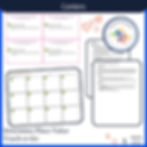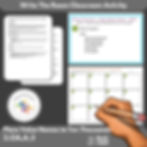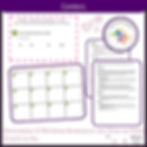It can be hard to get kids to stay on task, especially in a classroom setting. But with the right set of behavior goals, it's possible to help them focus and stay on track. In this article, we'll discuss 11 different IEP behavior goals that can help your students start and stay on task. We'll also provide tips on how to write effective goals, and share some resources that can help you get started.
Why do students need to have skills to help them stay on task?

Many students struggle to stay on task, especially when the subject matter may not be overly engaging or there are distractions within the classroom. As a result, they may suffer from poor grades and may get into trouble more frequently because their focus is on nonacademic activities. For these reasons, students need to have skills that will help them stay on task and complete work to be successful both in and out of the classroom.
Thankfully, several skills can help students stay on task and achieve greater success in the classroom. For instance, time management skills can be beneficial. Students who know how to budget their time wisely will be less likely to get sidetracked and will be more likely to complete their assignments on time. Likewise, practical study skills are essential for staying on task, and students who know how to take good notes and make study guides will be better prepared for tests and will be less likely to forget what they have learned. Finally, it is also important for students to develop good communication skills. Being able to express oneself clearly and concisely can help prevent misunderstandings and make it easier to ask for help when needed.
The goals of staying on task or completing work and how they vary
Numerous studies have shown that the ability to work independently and focus on tasks is important for students' success in school. However, this does not mean there's no room left over! It turns out we also should be concerned about off-task behaviors like fidgeting or talking too much--these activities can hamper your productivity just as much if not more, than they help it by taking away from valuable time spent completing the actual productive tasks at hand (which happens often enough).
On-task behavior is when students focus on what they're doing and don't get distracted by anything else. It's usually pretty easy to stay on task when on a cell phone or doing something they enjoy, like playing a sport. But it can be harder to focus when they're doing something difficult or boring, like math or writing in a classroom.
Work completion is when a student finishes the work that's assigned to them. It's an important life skill to finish work, especially if it's for school. Sometimes students don't complete their work because they don't understand it or they don't have enough time.
What's the best way to keep your students on task? Well, it depends! There are many different goals for both on-task and work completion behavior depending on who they're working with as well as what type of activity or task we're talking about. This article will outline some examples so you can see when each one should be used - plus advice from an experienced teacher about how these techniques work in her classroom too!
The Benefits of Having IEPs With Specific Behavior Goals
Specific behavior IEP goals, especially on task behavior iep goals, are beneficial for all children but especially students with autism or ADHD who often struggle more to maintain focus on-task. These IEP goals may include staying engaged in a task for long periods of time, completing assigned tasks without help from others, and being able to start independent work when given permission by an adult.
Behavior goals can have a huge impact on the education and success of students. One study found that children with IEPs who were given specific behavior goals performed better in school than those without such goals, as they had improved attendance rates or completed tasks more often! These findings suggest there is something beneficial about making sure your child has challenging but achievable behavioral objectives set for them at all times.
Setting up specific behavior goals for your student can be a challenge, but it is definitely worth the effort. The best way to do this is to work with your student's psychologist to come up with goals that are appropriate for them. It is important to keep in mind that these goals should be achievable and realistic. You also want to make sure that the goals are challenging enough to push your child to their best, but not so difficult that they become discouraged.
| More hand-picked content you may find helpful: |
|---|---|
|
6 IEP Goals for Staying on Task
Remain on Task IEP Goals and Objectives
Below is a list of behavior iep goals for task initiation that start from success with verbal prompting all the way through a gradual release to full independence. This goal chain will continue into the iep goal category of On Task Time sustainment further below.
Students can't remain on a task unless they can initiate a task.
By (date), when given a task or direction, the student will begin that task within one minute with no more than 2 verbal prompts, improving task initiation skills from 0/10 task opportunities to 8/10 task opportunities.
By (date), when given an assigned task or direction, the student will begin that task within one minute with no more than 1 verbal prompt, improving task initiation skills from 0/10 task opportunities to 8/10 task opportunities.
By (date), when given an assigned task or direction, the student will begin that task within one minute with 0 verbal prompts and no more than 2 gestural prompts, improving task initiation skills from 0/10 task opportunities to 8/10 task opportunities.
By (date), when given a task or direction, the student will begin that task within one minute with 0 verbal prompts and no more than 1 gestural prompt, improving task initiation skills from 0/10 task opportunities to 8/10 task opportunities.
By (date), when given a task or direction, the student will begin that task within one minute with 0 verbal prompts and 0 gestural prompts, improving task initiation skills from 0/10 task opportunities to 8/10 task opportunities.
By (date), when given a task or direction, the student will begin that task independently within one minute, improving task initiation skills from 0/10 task opportunities to 8/10 task opportunities.
6 IEP Goals for Completing Work
Work Completion IEP Goals and Objectives
By (date), when given a task or assignment, the student will begin that task within one minute and stay on task for at least 5 minutes with no more than 2 verbal prompts, improving task initiation skills from 0/10 task opportunities to 8/10 task opportunities.
By (date), when given a task or assignment, the student will begin that task within one minute and stay on task for at least 10 minutes with no more than 1 verbal prompt, improving task initiation skills from 0/10 task opportunities to 8/10 task opportunities.
By (date), when given a task or assignment, the student will begin that task within one minute and stay on task for at least 15 minutes with 0 verbal prompts and no more than 2 gestural prompts, improving task initiation skills from 0/10 task opportunities to 8/10 task opportunities.
By (date), when given a task or assignment, the student will begin that task within one minute and stay on task for at least 20 minutes with 0 verbal prompts and no more than 1 gestural prompt, improving task initiation skills from 0/10 task opportunities to 8/10 task opportunities.
By (date), when given a task or assignment, the student will begin that task independently, complete it within one minute, and stay on task for at least 10 minutes, improving task initiation skills from 0/10 task opportunities to 8/10 task opportunities.
As you can see, the time duration and prompting levels can be mixed and matched to best meet the students where they are in the learning progression. Feel free to play with them and develop a set that meets your individual teaching style.
Students who struggle with on-task behavior may benefit from setting up specific goals for their work habits. Whether you're trying to improve task initiation skills, work completion, or anything in between, having goal-oriented behavior interventions in place can be very helpful.
One way to set up these goals is to use a graduated intervention system. This means that you start with easier goals and gradually increase the difficulty as the student demonstrates mastery of the previous level. For example, you might start with a goal that says the student will stay on task for a specific amount of time, independently begin a task, or complete assigned tasks.
If the student has difficulty meeting these goals, you can provide them with more support in the form of verbal prompts, gestural prompts, or a combination of the two. As the student improves, you can gradually reduce your support until they can independently meet the goal.
4 IEP Goals for Common School Behavior
Task Related - Adaptive IEP Goal
By (date), when a student is given a classroom-based task, the student will stay on task for a specified amount of time (3-5 minutes), improving task-related skills from 0/10 task opportunities to 8/10 task opportunities.
Self Advocacy - Asking for Help IEP Goal
By (date), when a student does not understand directions, tasks, or assignments, the student will ask for help by raising their hand to prompt teacher assistance, improving self-advocacy skills from 0/10 task opportunities to 8/10 task opportunities.
Self Advocacy - Asking for a Break IEP Goal
By (date), when a student requires a short task break (2-4 minutes), the student will ask for a break by raising their hand to prompt the teacher's approval, improving self-advocacy skills from 0/10 task opportunities to 8/10 task opportunities.
The time frame and what that break might look like in the classroom can determine on a case-by-case basis.
Attendance IEP Goal
By (date), when a student is attending any class, the student will stay in class for the entire scheduled class time, improving attendance from 10% of scheduled classroom time to 80% of scheduled classroom time.
| More hand-picked content you may find helpful: |
|
Adding Clarity to IEP Goals
Many helpful phrases can be added to an IEP goal to allow for clarity between settings and specificity in what data is to be collected. Also, clarity phrases can be used to show what tool or accommodation a student might be using to master an IEP goal.
Some clarity phrases that can be added to an IEP goal are listed below:
For the student to (mastery level) by (date), when given a task or assignment, the student will begin that task within one minute and stay on task for at least (increments of time) with no more than (amount of verbal or gestural prompts) to improve task initiation skills from (baseline data) to (target data).
For the student to (mastery level) by (date), when given a task or assignment, the student will independently begin that task within one minute and stay on task for at least (increments of time) with no more than (amount of verbal or gestural prompts) to improve task initiation skills from (baseline data) to (target data).
For the student to (mastery level) by (date), when given a task or assignment, the student will use (specific tool or accommodation) and begin that task within one minute and stay on task for at least (increments of time) with no more than (amount of verbal or gestural prompts) to improve task initiation skills from (baseline data) to (target data).
In a recent facebook teacher survey, each of the following clarity phrases was rated in the top 20% of most used by special education teachers. Using these clarity phrases, you can be confident that your IEP goals are clear, specific, and measurable.
When given a task or assignment, the student will:
Begin that task within one minute.
Stay on task for at least (increments of time)
Use (specific tool or accommodation)
self-monitoring checklist
self-monitoring system
self-regulation strategies
visual self-rating system
quiet space break
Show evidence of (level of mastery)
Achieve a score of (mastery level) on (standardized test)
Improve from (baseline data) to (target data)
Maintain (level of mastery) for (length of time)
Reduce the number of (unwanted behavior) from (baseline data) to (target data)
withdrawn behavior
unexpected behaviors
anxious or withdrawn behavior
undesired peer behavior
passive noncompliance or ignoring tasks
Increase the number of (desired behavior) from (baseline data) to (target data)
appropriate emotional response
appropriate coping strategies
utilize positive self-talk
With (amount of prompts), the student will independently (perform task)
adult reminder
With (amount of prompts), the student will (perform task)
observation and data
demonstrate the ability...
demonstrate problem solving skills
Were (location), the student will (perform task)
classroom environment
educational environment
By no means does this list cover every set of expected and unexpected behaviors, but one thing is for certain, adding clarity phrases to IEP goals can help ensure that they are specific, measurable, and achievable. By using phrases rated in the top 20% of most used by special education teachers, you can be confident that your goals are clear and will be easier to track progress.
| More hand-picked content you may find helpful: |
|
Data Collection for Student Behavior Goals
When it comes to setting goals for students with special needs, data collection is an important part of the process. There are a variety of ways to collect data on student behavior, and each has its own advantages and disadvantages. Here are five common types of data collection:
Measured by teacher: In this method, the teacher simply observes the student and records what he or she sees. This can be done using a chart or a simple notebook. The advantage of this method is that it is relatively quick and easy to do. The downside is that it is subject to human error; the teacher may not be able to accurately record everything he or she sees.
Measured by teacher charted: This method is similar to the one above, but instead of simply recording observations, the teacher also charts them. This can be done using a software program or a simple spreadsheet. The advantage of this method is that it is more accurate than simply observing; the disadvantage is that it takes more time to set up and maintain.
Self-monitoring: In this method, the students themselves keep track of their own behavior. This can be done using a chart or a notebook. The advantage of this method is that it gives students a sense of ownership over their own behavior. The downside is that it is subject to human error; the students may not be able to accurately record everything they do.
Video recording: This method involves using a video camera to record the student's behavior. The advantage of this method is that it is very accurate; the downside is that it is time-consuming to set up and maintain. Only where parental consent, district guidelines, and all privacy guidelines up are adhered to.
Frequency count: This method involves counting the number of times a behavior occurs over a period of time. The advantage of this method is that it is quick and easy to do; the disadvantage is that it is subject to human error.
There are a variety of ways to collect data on student behavior, each with its own advantages and disadvantages. The most important part of setting goals for students with special needs is to make sure that the data collected is accurate and reflects the student's current level of functioning.
5 Types of Task Avoidance
Special education students often face challenges in the classroom that can make it difficult for them to complete assignments. As a result, they may resort to various task avoidance behaviors. Some common examples of task avoidance include:
1. Refusal to start the assignment: The student may claim that they don't know how to get started or that the task is too difficult.
2. Procrastination: The student may start the assignment but stall, either by taking frequent breaks or working on other tasks.
3. Working slowly: The student may deliberately drag out the assignment by taking a long time to complete each step.
4. Distraction: The student may find ways to distract themselves from the task at hand, such as talking to other students or looking at their phones.
5. Giving up: The student may stop working on the assignment altogether, even if they are making progress.
Task avoidance can be a significant obstacle for special education students, but it's important to remember that there are strategies that can help. For example, breaking the assignment down into smaller steps, setting a timer, and providing incentives for completing the task can all effectively deal with this type of behavior.
Connecting Self-Regulation to Staying on Task and Work Completion
Self-regulation is a necessary skill for students to develop in order to be successful both inside and outside of the classroom. Many students who receive an Individualized Education Program (IEP) have difficulty regulating their behavior and need support in order to be successful.
Success can be the key to unlocking the goals of staying on task and work completion. Students who utilize coping strategies are more likely to remain on task. They are also more likely to complete independent tasks as well as demonstrate less time focused on task avoidance. Connecting self-regulation behavior IEP goals can be a pathway to other goal success when a student is struggling to complete assigned tasks or stay on task in a calm and positive manner.
Maturity Has Its Benefits
Maturity can be a helpful factor in this process, as students mature, they often develop their own coping strategies and self-regulation skills based on their experiences in other environments. Making older students often better able to monitor their own progress and make necessary changes. However, even younger students can benefit from being taught how to self-monitor their progress toward an IEP goal. By supporting students as they develop these important skills, educators can help them become more successful in achieving their goals.
Thank you for reading! We hope this article has been helpful in setting up specific goals for on-task behavior. Be sure to follow us on social media for more great content like this!
FAQ
What is considered small group instruction or small group setting?
Small group instruction is when a teacher works with a small group of students on a specific task or skill. This can be an effective way to provide targeted support to students who are struggling with a particular concept or skill.
What is considered one-to-one instruction?
How do I set up an IEP goal for on-task behavior?
What are some common task avoidance behaviors?
How can I help my student achieve their IEP goals?
What is self-regulation?
How can maturity help with self-regulation?
What are some common IEP goals for behavior?
How can I help my student stay on task?
What are some common distractions for students?
How can I help my student avoid task avoidance behaviors?
What are some common consequences of task avoidance behaviors?
| More hand-picked content you may find helpful: |
|
































